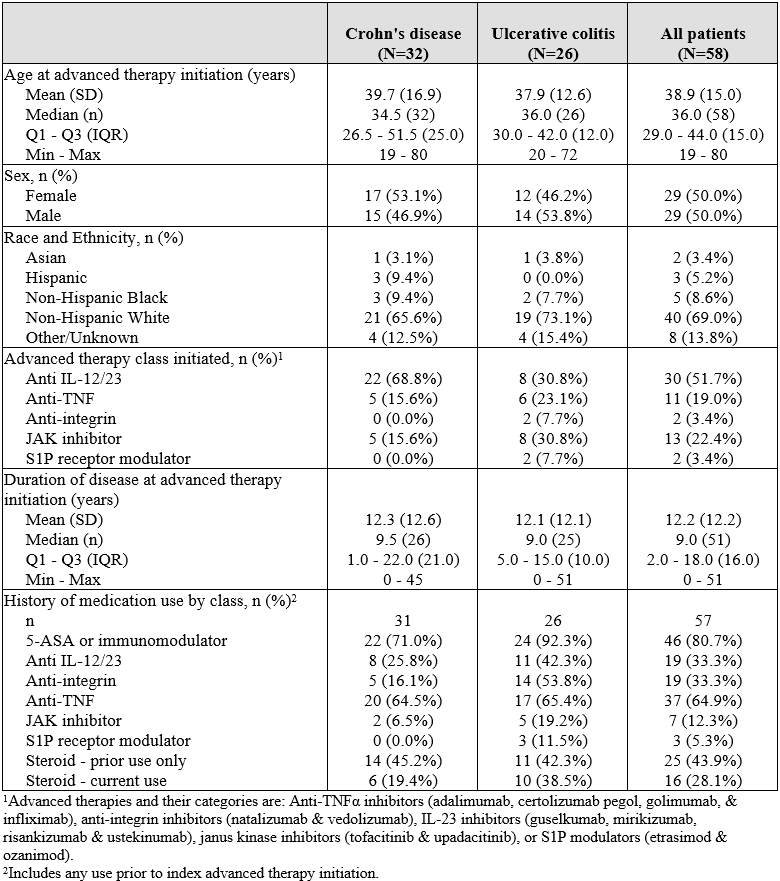Sunday Poster Session
Category: IBD
P1095 - Disability, Fatigue and Persistent Symptoms in Patients With Inflammatory Bowel Disease 6 Months After Initiation of Advanced Therapy: Insights From TARGET-IBD
Sunday, October 26, 2025
3:30 PM - 7:00 PM PDT
Location: Exhibit Hall

Gui Liu, PhD, MPH (she/her/hers)
Merck Sharp & Dohme LLC
Philadelphia, PA
Presenting Author(s)
Millie D. Long, MD, FACG1, Gui Liu, PhD, MPH2, Ebuwa Igho-Osagie, MBBS, DPH, MBA3, Julie M. Crawford, MD4, Keith D. Knapp, PhD4, Derek R. Gazis, MS4, Jeremy Shao, MD, PhD5, Bruce E. Sands, MD, MS, FACG6
1Division of Gastroenterology and Hepatology, University of North Carolina at Chapel Hill, Chapel Hill, NC, USA, Chapel Hill, NC; 2Merck Sharp & Dohme LLC, Philadelphia, PA; 3Merck, Rahway, NJ; 4Target RWE, Durham, NC; 5Merck & Co, South San Francisco, CA; 6Dr. Henry D. Janowitz Division of Gastroenterology, Icahn School of Medicine at Mount Sinai, New York, NY, USA, New York, NY
Introduction: We assessed whether real world patients with Crohn’s disease (CD) or ulcerative colitis (UC) are meeting STRIDE II treatment targets. These results are from an ongoing study.
Methods: This substudy prospectively enrolls adults with CD or UC from 15 community or academic sites in the longitudinal US-based consortium, TARGET-IBD. Gastroenterologists consent patients to complete patient reported outcomes (PROs) at 6 months (+/- 4 weeks) after initiating advanced therapy (AT). We excluded UC patients with prior total colectomy. Analytic outcomes were: inflammatory bowel disease disability index (IBD-DI, score of ≥15 indicates mild or worse disability), FACIT-Fatigue (score of < 30 indicates severe fatigue), PRO-2 CD, PRO-2 UC and NRS Urgency. PRO-2 CD active disease is stool frequency >2.8 stools/day or abdominal pain >1.0 (range 0-3). PRO-2 UC active disease is stool frequency of more than 1-2 stools per day more than normal or any rectal bleeding. Active bowel urgency is a score ≥2. Patient characteristics and PROs were analyzed descriptively.
Results: Of 196 patients currently enrolled, 58 (32 CD and 26 UC) had completed 6-month PROs at the datacut, with mean (SD) age of 38.9 years (15.0), 50% female, and 40 (69%) Non-Hispanic White. Table 1 shows the distribution of treatments. In the following, denominators represent respondent counts for each PRO.
Most patients (41 of 55, 75%) reported mild or worse disability (76% CD and 73% UC). 26 patients (46%) reported severe fatigue (53% CD and 38% UC).
The mean PRO-2 CD score was 6.7 (5.7). CD patients had a mean of 1.7 (2.0) soft stools/day and mean abdominal pain score of 0.7 (0.7). 6 CD patients (19%) reported >2.8 soft stools/day; 7 CD patients (23%) reported abdominal pain score >1.
The mean PRO-2 UC score was 1.3 (1.3), 5 patients (20%) reported ≥3 “stools/day more than normal”, and 6 (24%) patients reported rectal bleeding. 16 (64%) UC patients were in remission.
Of 49 patients responding to the NRS Urgency measure, 33 (67%) reported bowel urgency (≥2). Among 31 CD patients, 25 (81%) reported bowel urgency, mean score 3.5 (2.6). 8 of 18 UC patients (44%) reported bowel urgency, mean 2.8 (3.0).
Discussion: In this analysis of 58 patients with moderate to severe CD or UC, many still had suboptimal quality of life 6 months after starting AT. Numerous patients missed STRIDE-II treatment goals, especially in disability and fatigue. These findings show key unmet needs in IBD care.

Figure: Table 1. Demographic and clinical characteristics of the study population by disease type
Disclosures:
Millie Long: AbbVie – Consultant. Bristol Myers Squibb – Consultant. Celltrion – Consultant, Grant/Research Support. Intercept – Consultant. Johnson & Johnson – Consultant. Lilly – Consultant, Grant/Research Support. Merck – Consultant. Pfizer – Consultant, Grant/Research Support. Prometheus – Consultant. Roivant – Consultant. Sanofi – Consultant. Spyre – Consultant. Takeda – Consultant, Grant/Research Support. Target RWE – Consultant.
Gui Liu: Merck Sharp & Dohme LLC, a subsidiary of Merck & Co., Inc – Employee.
Ebuwa Igho-Osagie: Merck & Co., Inc., Rahway, NJ, USA – Employee.
Julie Crawford: Target RWE – Employee, Stock Options.
Keith Knapp: Target RWE – Employee, Stock Options.
Derek Gazis: Target RWE – Employee, Stock Options.
Jeremy Shao: Merck Sharp & Dohme LLC – Employee, Stock Options.
Bruce Sands: AbbVie – Consultant. Abivax – Consultant, speaking fees. Adiso Therapeutics – Consultant. Agomab Therapeutics – Consultant. Alimentiv – Consultant. Amgen – Consultant. AnaptysBio – Consultant. Arena Pharmaceuticals – Consultant. Artugen Therapeutics – Consultant. Astra Zeneca – Consultant. Biolojic Design – Consultant. Biora Therapeutics – Consultant. Boehringer Ingelheim – Consultant. Boston Pharmaceuticals – Consultant. Bristol Myers Squibb – Consultant, Grant/Research Support, speaking fees. Calibr – Consultant. Celgene – Consultant. Celltrion – Consultant. ClostraBio – Consultant. Eli Lilly & Company – Consultant, speaking fees. Enthera – Consultant. Enveda Biosciences – Consultant. Equillium – Consultant. Evommune – Consultant. Ferring – Consultant. Fresenius Kabi – Consultant. Fzatat – Consultant. Galapagos – Consultant. Genentech (Roche) – Consultant. Gilead Sciences – Consultant. GlaxoSmithKline – Consultant. Gossamer Bio – Consultant. Imhotex – Consultant. Index Pharmaceuticals – Consultant. Innovation Pharmaceuticals – Consultant. Inotrem – Consultant. Janssen R&D – Consultant, Grant/Research Support, speaking fees. Kaleido – Consultant. Kallyope – Consultant. Merck & Co., Inc., Rahway, NJ, USA – Consultant. Microba – Consultant. Mobius Care – Consultant. Morphic Therapeutics – Consultant. MRM Health – Consultant. Nexus Therapeutics – Consultant. Nimbus Discovery – Consultant. Odyssey Therapeutics – Consultant. Pfizer – Consultant, Grant/Research Support, speaking fees. Progenity – Consultant. Prometheus Biosciences – Consultant. Prometheus Laboratories – Consultant. Protagonist Therapeutics – Consultant. Q32 Bio – Consultant. Rasayana Therapeutics – Consultant. Recludix Therapeutics – Consultant. Reistone Biopharma – Consultant. Sanofi – Consultant. Spyre Therapeutics – Consultant. Sun Pharma – Consultant. Surrozen – Consultant. Takeda – Consultant, Grant/Research Support, speaking fees. Target RWE – Consultant. Teva – Consultant. Theravance Biopharma – Consultant, Grant/Research Support. TLL Pharmaceutical – Consultant. Tr1X – Consultant. Union Therapeutics – Consultant. Ventyx Biosciences – Consultant, Stock Options.
Millie D. Long, MD, FACG1, Gui Liu, PhD, MPH2, Ebuwa Igho-Osagie, MBBS, DPH, MBA3, Julie M. Crawford, MD4, Keith D. Knapp, PhD4, Derek R. Gazis, MS4, Jeremy Shao, MD, PhD5, Bruce E. Sands, MD, MS, FACG6. P1095 - Disability, Fatigue and Persistent Symptoms in Patients With Inflammatory Bowel Disease 6 Months After Initiation of Advanced Therapy: Insights From TARGET-IBD, ACG 2025 Annual Scientific Meeting Abstracts. Phoenix, AZ: American College of Gastroenterology.
1Division of Gastroenterology and Hepatology, University of North Carolina at Chapel Hill, Chapel Hill, NC, USA, Chapel Hill, NC; 2Merck Sharp & Dohme LLC, Philadelphia, PA; 3Merck, Rahway, NJ; 4Target RWE, Durham, NC; 5Merck & Co, South San Francisco, CA; 6Dr. Henry D. Janowitz Division of Gastroenterology, Icahn School of Medicine at Mount Sinai, New York, NY, USA, New York, NY
Introduction: We assessed whether real world patients with Crohn’s disease (CD) or ulcerative colitis (UC) are meeting STRIDE II treatment targets. These results are from an ongoing study.
Methods: This substudy prospectively enrolls adults with CD or UC from 15 community or academic sites in the longitudinal US-based consortium, TARGET-IBD. Gastroenterologists consent patients to complete patient reported outcomes (PROs) at 6 months (+/- 4 weeks) after initiating advanced therapy (AT). We excluded UC patients with prior total colectomy. Analytic outcomes were: inflammatory bowel disease disability index (IBD-DI, score of ≥15 indicates mild or worse disability), FACIT-Fatigue (score of < 30 indicates severe fatigue), PRO-2 CD, PRO-2 UC and NRS Urgency. PRO-2 CD active disease is stool frequency >2.8 stools/day or abdominal pain >1.0 (range 0-3). PRO-2 UC active disease is stool frequency of more than 1-2 stools per day more than normal or any rectal bleeding. Active bowel urgency is a score ≥2. Patient characteristics and PROs were analyzed descriptively.
Results: Of 196 patients currently enrolled, 58 (32 CD and 26 UC) had completed 6-month PROs at the datacut, with mean (SD) age of 38.9 years (15.0), 50% female, and 40 (69%) Non-Hispanic White. Table 1 shows the distribution of treatments. In the following, denominators represent respondent counts for each PRO.
Most patients (41 of 55, 75%) reported mild or worse disability (76% CD and 73% UC). 26 patients (46%) reported severe fatigue (53% CD and 38% UC).
The mean PRO-2 CD score was 6.7 (5.7). CD patients had a mean of 1.7 (2.0) soft stools/day and mean abdominal pain score of 0.7 (0.7). 6 CD patients (19%) reported >2.8 soft stools/day; 7 CD patients (23%) reported abdominal pain score >1.
The mean PRO-2 UC score was 1.3 (1.3), 5 patients (20%) reported ≥3 “stools/day more than normal”, and 6 (24%) patients reported rectal bleeding. 16 (64%) UC patients were in remission.
Of 49 patients responding to the NRS Urgency measure, 33 (67%) reported bowel urgency (≥2). Among 31 CD patients, 25 (81%) reported bowel urgency, mean score 3.5 (2.6). 8 of 18 UC patients (44%) reported bowel urgency, mean 2.8 (3.0).
Discussion: In this analysis of 58 patients with moderate to severe CD or UC, many still had suboptimal quality of life 6 months after starting AT. Numerous patients missed STRIDE-II treatment goals, especially in disability and fatigue. These findings show key unmet needs in IBD care.

Figure: Table 1. Demographic and clinical characteristics of the study population by disease type
Disclosures:
Millie Long: AbbVie – Consultant. Bristol Myers Squibb – Consultant. Celltrion – Consultant, Grant/Research Support. Intercept – Consultant. Johnson & Johnson – Consultant. Lilly – Consultant, Grant/Research Support. Merck – Consultant. Pfizer – Consultant, Grant/Research Support. Prometheus – Consultant. Roivant – Consultant. Sanofi – Consultant. Spyre – Consultant. Takeda – Consultant, Grant/Research Support. Target RWE – Consultant.
Gui Liu: Merck Sharp & Dohme LLC, a subsidiary of Merck & Co., Inc – Employee.
Ebuwa Igho-Osagie: Merck & Co., Inc., Rahway, NJ, USA – Employee.
Julie Crawford: Target RWE – Employee, Stock Options.
Keith Knapp: Target RWE – Employee, Stock Options.
Derek Gazis: Target RWE – Employee, Stock Options.
Jeremy Shao: Merck Sharp & Dohme LLC – Employee, Stock Options.
Bruce Sands: AbbVie – Consultant. Abivax – Consultant, speaking fees. Adiso Therapeutics – Consultant. Agomab Therapeutics – Consultant. Alimentiv – Consultant. Amgen – Consultant. AnaptysBio – Consultant. Arena Pharmaceuticals – Consultant. Artugen Therapeutics – Consultant. Astra Zeneca – Consultant. Biolojic Design – Consultant. Biora Therapeutics – Consultant. Boehringer Ingelheim – Consultant. Boston Pharmaceuticals – Consultant. Bristol Myers Squibb – Consultant, Grant/Research Support, speaking fees. Calibr – Consultant. Celgene – Consultant. Celltrion – Consultant. ClostraBio – Consultant. Eli Lilly & Company – Consultant, speaking fees. Enthera – Consultant. Enveda Biosciences – Consultant. Equillium – Consultant. Evommune – Consultant. Ferring – Consultant. Fresenius Kabi – Consultant. Fzatat – Consultant. Galapagos – Consultant. Genentech (Roche) – Consultant. Gilead Sciences – Consultant. GlaxoSmithKline – Consultant. Gossamer Bio – Consultant. Imhotex – Consultant. Index Pharmaceuticals – Consultant. Innovation Pharmaceuticals – Consultant. Inotrem – Consultant. Janssen R&D – Consultant, Grant/Research Support, speaking fees. Kaleido – Consultant. Kallyope – Consultant. Merck & Co., Inc., Rahway, NJ, USA – Consultant. Microba – Consultant. Mobius Care – Consultant. Morphic Therapeutics – Consultant. MRM Health – Consultant. Nexus Therapeutics – Consultant. Nimbus Discovery – Consultant. Odyssey Therapeutics – Consultant. Pfizer – Consultant, Grant/Research Support, speaking fees. Progenity – Consultant. Prometheus Biosciences – Consultant. Prometheus Laboratories – Consultant. Protagonist Therapeutics – Consultant. Q32 Bio – Consultant. Rasayana Therapeutics – Consultant. Recludix Therapeutics – Consultant. Reistone Biopharma – Consultant. Sanofi – Consultant. Spyre Therapeutics – Consultant. Sun Pharma – Consultant. Surrozen – Consultant. Takeda – Consultant, Grant/Research Support, speaking fees. Target RWE – Consultant. Teva – Consultant. Theravance Biopharma – Consultant, Grant/Research Support. TLL Pharmaceutical – Consultant. Tr1X – Consultant. Union Therapeutics – Consultant. Ventyx Biosciences – Consultant, Stock Options.
Millie D. Long, MD, FACG1, Gui Liu, PhD, MPH2, Ebuwa Igho-Osagie, MBBS, DPH, MBA3, Julie M. Crawford, MD4, Keith D. Knapp, PhD4, Derek R. Gazis, MS4, Jeremy Shao, MD, PhD5, Bruce E. Sands, MD, MS, FACG6. P1095 - Disability, Fatigue and Persistent Symptoms in Patients With Inflammatory Bowel Disease 6 Months After Initiation of Advanced Therapy: Insights From TARGET-IBD, ACG 2025 Annual Scientific Meeting Abstracts. Phoenix, AZ: American College of Gastroenterology.
